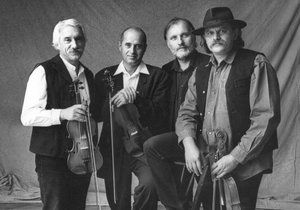Roots and Routes series III.
- Kodály: Háry Intermezzo
- Kodály: Dances from Marosszék
- Moldavian ballade, "Gergelytánc"
- Bartók: Hungarian Peasant melodies I.-II.
- Kodály: "A peacock takes its perch"
- Dohnányi: Ruralia Hungarica, II.
- Bartók: Transylvanian dances I.-II.
- Gyimesi with two gardons
- Bartók: Dance suites V.-VI.
- Muzsikás: Melodies from Kállai Double Dance
- Petrás Mária: Ballade
- Bartók: Romanian folk songs
Mária Petrás - singer, Zoltán Farkas, Ildikó Tóth - dancers, Muzsikás Folk Ensemble
Conductor: Zsolt Hamar

Concerto Budapest and Muzsikás perform together on several occasions in the 2016/17 season. Classical musicians with folk musicians, musicians with members of Muzsikás. However, in the 1970s it was not always sweetness and light between the two camps. Classical musicians looked on those playing urban (revival) folk music as people who couldn’t read sheet music, were semi-trained at best and unauthentic, while in turn they looked on classical musicians as sheet music reading bores. There was something in both accusations. At the same time, these opinions were exaggerated, frequently unjust and indications of the lack of understanding of the other side. In other words, there was a desperate need for both sides to recognize the other’s values and perhaps even use them in their own music. Furthermore, this would open the door to the possibility of ground-breaking joint concerts. Muzsikás first initiated such enterprises in 1995, taking part in combined undertakings both here in Hungary and abroad, for example at the Theatre de la Ville, Paris, the Royal Albert Hall, London, Carnegie Hall, New York, and Santa Cecilia, Rome. Here in Hungary, among the early takers were András Keller and the Keller Quartet. I was particularly interested in this process and I understood both sides of the argument because to a certain extent I belonged to both camps.
I attended the Lorántffy Street music school in Budapest, in the very class in which the school grew up. Kodály himself was a frequent visitor, closely observing our music education. Occasionally he was accompanied by outstanding musicians who sat in on our classes and then returned the favour by playing for us. There were memorable moments when we could hear and watch from close up such greats as Yehudi Menuhin and Pablo Casals. Classical music and choral singing were everyday parts of our lives. Folk music was similarly a part because we regularly sang folk songs and variations on folk songs from sheet music or by ear. At the same time, it is worth mentioning that we had never heard an authentic folk song recording. True, it could be that there was no opportunity for this at that point in history. I, for one, couldn’t even begin to imagine authentic instrumental folk music being recorded in a dance, ball or at a peasant wedding. But this, too, came about… We began to consider how the two genres could be woven together by listening to the collection and the work alongside each other. Initially at the emotional, experiential level, a level barely able to be approached through words. When the composer presents the collection in virtually unchanged form, then playing music together is also possible.
To mention just a few of the better known examples: the peacock melody of Bartók, Kodály and others, Bartók’s violin duos or his Improvisations on Hungarian Peasant Songs, Romanian folk dances etc. These connections become apparent to the listener in a very tangible way. It does a person good, and not only for those who are cognoscenti but also for those hearing this for the first time. Folk music performance gives the opportunity to digest, or prepare for, a Bartók work, for instance. Or the person is captured if he/she perceives the until then unknown form, or maybe forms, of that particular musical concept. We can be witnesses to these connections at several concerts by Budapest Concerto and Muzsikás in the 2016/17 season.
Mihály Sipos/ Muzsikás
